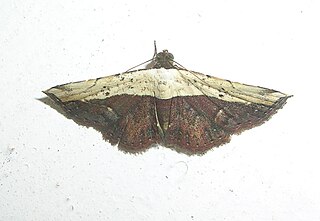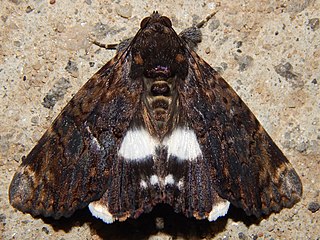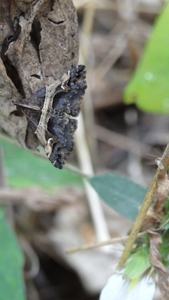
Callopistria maillardi is a moth of the family Noctuidae. The species can be found throughout central, eastern and southern Africa, including the islands of the Indian Ocean, Yemen, Chagos islands, Pakistan, India, Sri Lanka, southern China, in Hawaii, Hong Kong, New Zealand, the Society Islands, Sulawesi, as well as Queensland in Australia.

Yepcalphis is a monotypic moth genus of the family Noctuidae erected by Nye in 1975. Its only species, Yepcalphis dilectissima, was first described by Francis Walker in 1858. It is found in Sri Lanka, the Oriental tropics, the Philippines, Sulawesi and the Sula Islands.

Egnasia is a genus of moths of the family Erebidae. The genus was first described by Francis Walker in 1859.

Ctenoplusia limbirena, the Scar Bank gem, or silver U-tail, is a moth of the family Noctuidae. It is found in south-western Europe, Africa, the Canary Islands, Arabia, the southern Himalayas, India, Sri Lanka, Indochina to south-eastern China, Taiwan, Sulawesi, Bali and Timor. In New Zealand, it has been established since 2011.

Eucyclodes gavissima, the Oriental orange banded green geometer moth, is a species of moth of the family Geometridae described by Francis Walker in 1861. It is found in the Indian subregion, Sri Lanka, Bhutan, western China, Taiwan, Sumatra and Borneo.

Ctenoplusia albostriata, the eastern streaked plusia, is a moth of the family Noctuidae. It is found in India, Sri Lanka, eastern Asia and the Pacific, including Borneo, Hong Kong, Vietnam, Japan, most of Australia and New Zealand.
Trichoplusia lectula is a moth of the family Noctuidae first described by Francis Walker in 1858. It is found throughout Asia, including the Indian subregion, Sri Lanka, Thailand, Borneo, Java, Japan, as well as Western Australia and Queensland.

Oruza divisa is a species of moth of the family Erebidae first described by Francis Walker in 1862. It is found in Asia, including Hong Kong, Sri Lanka, Sulawesi, Taiwan, Japan and in Africa south of the Sahara, including Indian Ocean islands.

Teulisna tumida is a species of moth of the family Erebidae first described by Francis Walker in 1862. It is found in Borneo, Sumatra, China, India, Sri Lanka, Thailand and Taiwan.

Lamoria anella is a species of snout moth described by Michael Denis and Ignaz Schiffermüller in 1775 found in Africa, Asia and Europe.

Hypena obacerralis is a moth of the family Erebidae. It is found throughout Africa, the Middle East and South Asia and Malaysia.

Phazaca theclata, the cotton leaf roller, is a moth of the family Uraniidae. It was first described by Achille Guenée in 1858. It is known from Africa south of the Sahara, from Saudi Arabia, as well as from India, Japan, Myanmar, Nepal and Sri Lanka.

Nagia linteola is a species of moth in the family Erebidae first described by Achille Guenée in 1852. This species occurs in South Africa, the Democratic Republic of the Congo, Yemen, the Comoros, Mauritius, Madagascar, Indonesia (Borneo), India, Sri Lanka, Myanmar, Thailand and in Australia, where it has been recorded from Western Australia, the Northern Territory, Queensland and Victoria.
Calamotropha anticella is a moth in the family Crambidae. It was described by Francis Walker in 1866. It is found in South Africa and Sri Lanka.
Oraesia provocans, the provocative calpe, is a moth of the family Erebidae. The species was first described by Francis Walker in 1858. It is found throughout continental Africa, India and Sri Lanka.

Bertula abjudicalis is a moth of the family Noctuidae first described by Francis Walker in 1859. It is found in India, Thailand, Laos, Vietnam, Taiwan and from Sri Lanka to Australia, where it has been recorded from New South Wales.

Egnasia ephyrodalis is a moth of the family Noctuidae first described by Francis Walker in 1858.

Callyna jugaria is a moth of the family Noctuidae first described by Francis Walker in 1858. It is found in Sri Lanka, India, China, Taiwan, Hong Kong and the Philippines.
Cryptaspasma brachyptycha is a moth of the family Tortricidae first described by Edward Meyrick in 1911. It is found in Sri Lanka and Australia.
Blenina accipiens is a moth of the family Nolidae first described by Francis Walker in 1858. It is found in India, Sri Lanka, Myanmar and Australia.














